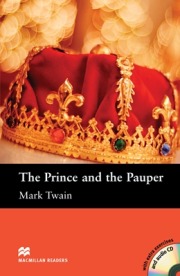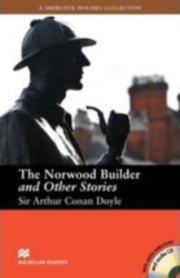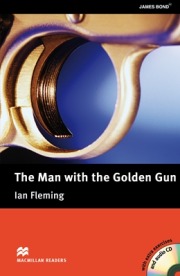Three New Readers from Macmillan
reviewed by Neil McBeath, Oman

The Prince and the Pauper
Mark Twain (Retold by Chris Rose) 2013
ISBN 978-023-0-43634-4 Pp. 71
Macmillan Readers.

The Norwood Builder and Other Tales
Sir Arthur Conan-Doyle (Retold by F.H. Cornish) 2013
ISBN 978-0-230-43646-6 Pp. 111
Macmillan Readers.

The Man with the Golden Gun
Ian Fleming (Retold by Helen Holwill) 2013
ISBN 978-023-0-42234-8 Pp. 103
Macmillan Readers.
These books all come at different levels. The Prince and the Pauper is graded at Elementary, with 1100 basic words and a CEFR rating of A2. The Norwood Builder is Intermediate – 1600 basic words and CEFR B1/B2, while the James Bond novel is at Upper level – 2200 basic words and B2.
All three books follow the Macmillan Graded reader house style. First comes the text, then comprehension questions and vocabulary and grammar exercises. The Norwood Builder and The Man with the Golden Gun also have glossaries, and lists of useful phrases. All three books also come with audio CDs. The Prince and the Pauper is read by a woman, and The Norwood Builder by a man, but both use standard South East of England pronunciation. The Man with the Golden Gun is read by a man whose pronunciation has slight traces of the English midlands.
So far as the individual texts are concerned, The Prince and the Pauper already exists in graded reader format, but this is the first Macmillan version. Originally published in Canada in 1881, and then issued in the USA a year later, the story is based on the American Republican conceit that all men are created equal, provided, that is, that they are white, Anglo-Saxon and protestant. Edward, Prince of Wales (later Edward VI) and Tom Canty qualify in most respects, although Tom was actually tutored by the saintly Father Andrew, and in reality would probably have held more closely to the older faith than the prince.
To be honest, the story is really the most utter nonsense. Mark Twain had, at best, a hazy grasp of snakepit of religious and political forces that tore at Tudor England, and his suggestion that Tom/Edward consorted happily with the Lady Elizabeth and the poor, doomed, Lady Jane Grey is the stuff of fantasy.
This retelling, moreover, shows an ever weaker grasp of reality. No Tudor prince would have eaten “beef and chicken with potatoes” (P. 11). Nor would Lady Jane, that paragon of protestant learning, and first martyr to the protestant work ethic, have said “You don’t look good…Are you OK, my prince?” (P. 17).
What is strangest, of course, is that Twain’s later book, Pudd’nhead Wilson (1894) shows a far more accurate depiction of the forces of nature and nurture. Thomas a Beckett Driscoll, being white, is born to a life of privilege. Valet de Chambre, being one thirty-second part black, is born a slave. When “Chambers’” mother switches the babies, she reverses this order, but when the truth emerges, some 20 years later, Chambers has gone utterly to the bad, and Tom’s upbringing renders him incapable of taking his “rightful” place in polite, white society. The reality is that suffering does not ennoble.
The Sherlock Holmes stories, by contrast, are jolly good yarns which have withstood the test of time because they are so firmly rooted in their own era. In this collection, the stories are The Norwood Builder; The Second Stain; The Stockbroker’s Clerk and A Scandal in Bohemia. It is interesting to be reminded that Norwood – now a shabby area next to Brixton – was once genteel and “on the southern edge of London” (P. 12), and Lady Hilda Hope (The Second Stain) is that late Victorian cliché – a lady with a past. In this instance we would see her past as a minor indiscretion, but times have changed.
Even so, it is difficult to understand how the King of Bohemia, six feet six inches tall and wearing fur-trimmed boots and draped in ”a cloak fastened with a brooch made of gold with a single large jewel in the centre” (P. 68) ever hoped to pass incognito through London.
The Man with the Golden Gun was Fleming’s last novel, published posthumously in 1965. It is, therefore, very much of the Cold War era, where the CIA are the good guys and the KGB are the baddies. How much of this knowledge can be assumed with a contemporary teenage/young adult audience is questionable.
This version is surprisingly readable, however, although there is one terrible misprint which makes nonsense of the ending. Having successfully disposed of the evil Scaramanga, the wounded Bond is informed that the British Prime Minister intends to recommend him for a knighthood. “This would be in addition to the KCMG that you already hold” (P. 75).
If Bond held a KCMG (Knight Commander of the Most Distinguished Order of St. Michael and St. George), he would already BE a knight, and would be addressed as "Sir James". In the original book, Bond holds (only?) a CMG, the rank of Companion in the same order of chivalry. This is a postnominal honour, but it does not carry a title.
On balance, therefore, these books are a mixed bag. The Sherlock Holmes stories maintain their appeal, and have the added advantage of dealing with white-collar crimes like blackmail and fraud rather than violence and death. The Prince and the Pauper will probably find a market, but I would seriously question the need for yet another version of this novel. James Bond remains Mr. Bond, although in some ways a double knighthood might have been a fitting end to his career.

Please check the How the Motivate your Students course at Pilgrims website.
Please check the Literature course at Pilgrims website.
Please check the Methodology and Language for Primary Teachers course at Pilgrims website.
Please check the Methodology and Language for Secondary Teachers course at Pilgrims website.


|